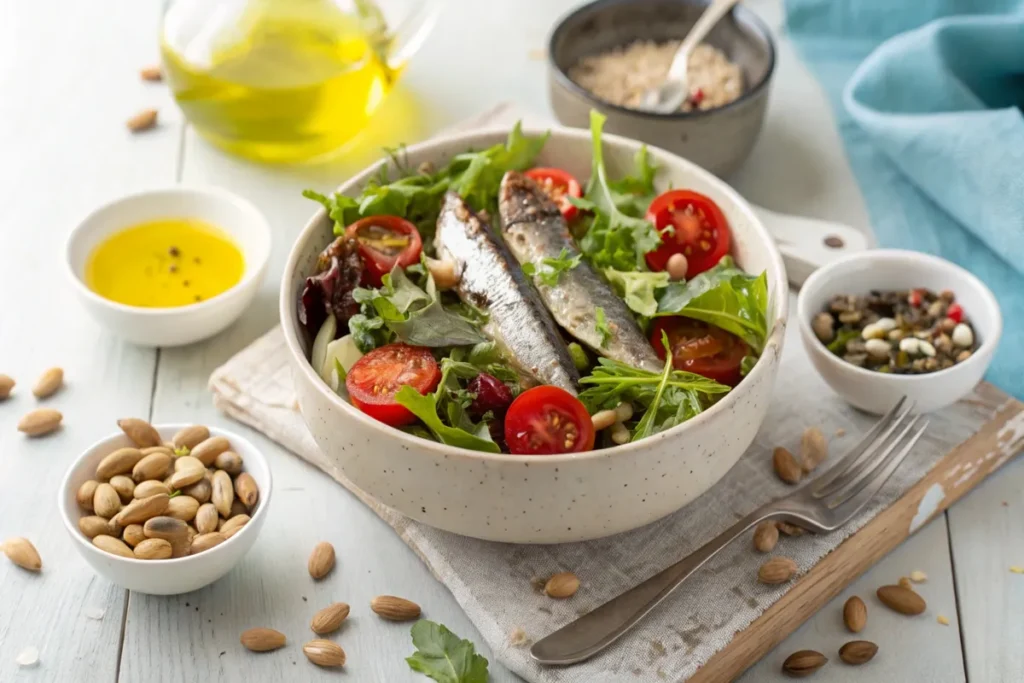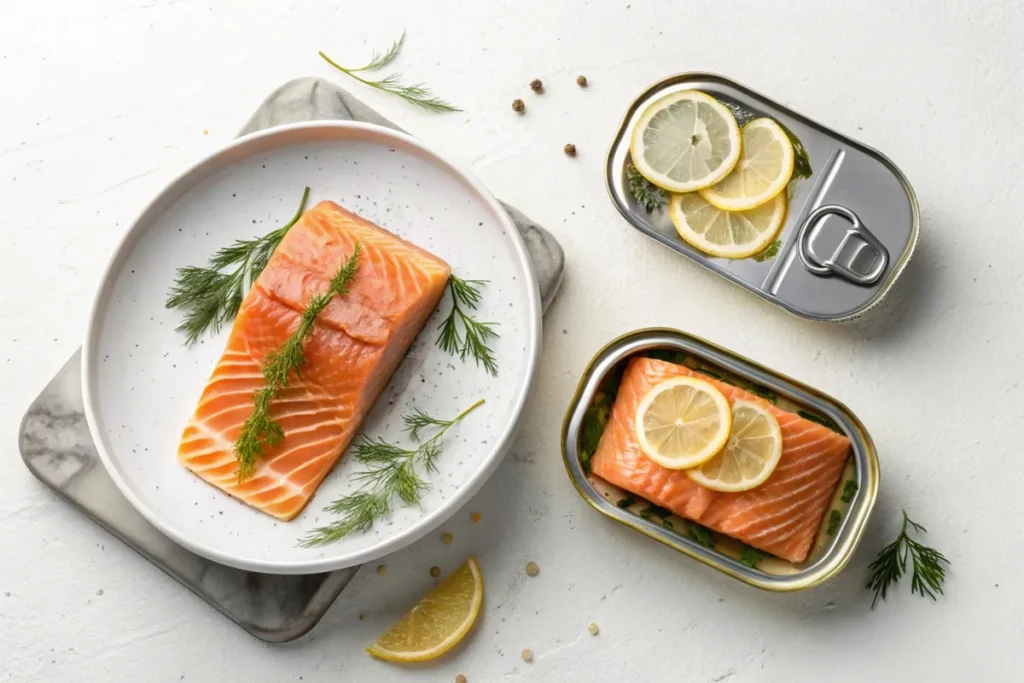Many people wonder if tinned fish are healthy. This question arises when individuals seek easy, budget-friendly protein sources that are nutritious. Canned fish has gained attention for its nutritional value and omega-3 benefits.
This guide will explore these topics. We’ll look at different types of tinned seafood, discuss their health impacts, and see how these proteins can fit into your daily meals. Let’s dive in and discover everything about these versatile pantry staples!
Table of contents
Understanding Tinned Fish
Definition and Types of Canned Seafood
Tinned fish refers to various species, such as salmon, tuna, sardines, anchovies, and mackerel, sealed in cans with water, oil, or sauce. Producers pre-cook these fish at high temperatures to eliminate bacteria and extend shelf life. This shelf-stable protein source is popular for its convenience.
Just pop open a can for a ready-to-eat ingredient or meal component. Options vary; you can choose between sardines in olive oil or water and canned salmon or fresh salmon. Each type offers a distinct flavour, texture, and nutritional profile.
Brief History and Popularity of Tinned Fish
Canning fish began in the early 19th century when innovators sought ways to preserve seafood efficiently. Over time, tinned fish became a household staple, especially during wartime and economic hardships, due to its long shelf life and affordability. Today, we still appreciate these products for similar reasons.
However, many consumers also focus on healthy seafood recipes. Demand has surged recently as more people discover how tinned fish contributes to a high-protein diet without breaking the bank. If you’re pondering, are tinned fish healthy?—stay tuned. The following sections will explore nutrition and sustainability.
Give your next pasta night a flavorful twist by harnessing the ‘holy trinity of tinned fish’—tuna, sardines, and anchovies a surprisingly delicious meal. See our full recipe here: https://www.vitalyrecipes.com/tinned-fish-pasta/”
Nutritional Profile: Why Are Tinned Fish Healthy?
Protein Content and Omega-3 Fatty Acids
Protein stands out when discussing canned fish health. Many tinned varieties provide a significant protein boost for your kitchen, helping to build and repair muscles. Protein also supports healthy bones, skin, and hormones. A single serving of tuna or salmon offers a substantial increase in daily protein intake at a low cost, making it a convenient protein source for on-the-go meals.
Fatty fish like sardines and mackerel deliver omega-3 benefits, supporting brain health, reducing inflammation, and nurturing your heart. These healthy fats help maintain normal cholesterol levels and may lower triglycerides, another key factor for overall well-being. Sardines in olive oil and water vary in fat content, but both contain valuable nutrients. By choosing the right type of tinned seafood, you can tailor your meals to meet your dietary preferences and maximize omega-3 benefits.
Essential Vitamins and Minerals Found in Canned Seafood
Besides protein and healthy fats, the nutritional value of tinned fish includes essential vitamins and minerals like vitamin D, vitamin B12, and calcium. Vitamin D supports bone health and immune function, while vitamin B12 fuels red blood cell formation. Sardines and salmon rank high in these nutrients, making vitamins in sardines and salmon a hot topic among health enthusiasts.
Many varieties also offer a solid dose of calcium, especially when you eat the soft, edible bones in canned sardines or salmon. They are loaded with omega-3 fats and bolster your skeletal system—an important win for anyone seeking healthy seafood recipes. As a result, tinned fish stands out as a shelf-stable protein source that delivers a broad spectrum of vitamins, minerals, and other elements vital to a balanced lifestyle.
Health Benefits of Eating Canned Fish

Cardiovascular Advantages and Heart-Healthy Fats
Many doctors praise oily fish for their healthy fats and heart health benefits. Tinned salmon, sardines, and mackerel lead the list of fatty fish that can keep your heart in excellent shape. Omega-3 benefits in these fish help lower the risk of certain cardiovascular problems. Research suggests that adding them to meals can maintain healthy blood pressure levels and reduce inflammation. When people ask if tinned fish are healthy, they often refer to these heart-protective benefits.
If you worry about mercury in tuna, opt for light tuna packed in water. Light tuna typically contains lower mercury levels than albacore. Remember to consume fish in moderation. By rotating your fish choices—such as sardines, salmon, and tuna—you can enjoy a variety of flavours while keeping mercury exposure low.
Bone and Joint Health Benefits of Canned Sardines and Salmon
Canned seafood like sardines and salmon can strengthen your bones. Producers pressure-cook their bones until they soften, keeping the calcium intact and boosting the mineral content. Many people believe tinned sardines help maintain strong bones and joints because they are high in vitamin D and calcium.
For those with busy lifestyles, these ready-to-eat options fit seamlessly into meal prepping. You can add them to salads, sandwiches, or soups without sacrificing taste or contributing to food waste. Additionally, enjoying these seafood staples complements a low-carb meal plan. If you want to support bone strength while reaping cardiovascular benefits, tinned fish—from salmon to sardines—deserves a spot in your pantry.
“Ready to break free from your weeknight dining rut? Spice things up with a puttanesca pasta featuring are-you-sure-these-are-anchovies? white anchovies that act more like sardines Get all the tasty details at: https://www.vitalyrecipes.com/tinned-fish-pasta/”
Potential Concerns: Are Tinned Fish Healthy?
Mercury Levels and Contaminants in Canned Seafood
While tinned fish offers plenty of benefits, some consumers worry about mercury and other contaminants. Indeed, certain species—giant, long-lived fish like albacore tuna—tend to contain more mercury. Yet many brands test their products to ensure safety.
Moreover, rotating different types of fish (such as tuna, sardines, and salmon) can help minimize exposure. Also, organizations like the FDA provide guidelines on safe serving sizes. Therefore, as long as you diversify and moderate, you can still enjoy the nutritional value of tinned fish.
Additionally, some people question BPA in canned seafood packaging. However, many companies have switched to BPA-free linings to ease consumer worries. Even so, it’s wise to check labels or company websites for confirmation. That way, you stay informed about which brands prioritize safer canning methods.
Sodium Content and How to Manage Your Intake
Another common concern involves sodium. Some tinned fish, particularly those packed in brine, can come with a hefty salt load. However, you can look for low-sodium versions or rinse the fish underwater to reduce salt before eating.
Moreover, pairing it with fresh herbs or unsalted sides can further help balance your total sodium count. Thus, many individuals wonder, Are tinned fish healthy? The short answer is yes, as long as they take steps to regulate sodium and keep track of mercury levels.
Comparing Tinned Fish to Fresh Fish

Nutritional Similarities and Differences
People often ask how canned salmon vs. fresh salmon stack up in nutrients. Generally, both forms are rich in protein, omega-3 benefits, and essential vitamins like B12. Tinned versions sometimes include edible bones, which add extra calcium.
Meanwhile, fresh fish often boasts a slightly different taste and texture. Nevertheless, if you’re short on time, canned options are convenient and cost-effective. Moreover, the gains in healthy fats and heart health remain largely the same between canned and fresh varieties.
Similarly, sardines in olive oil vs. water reveal slight differences in overall fat content and calories, but both provide key nutrients. Thus, you can pick a type that fits your dietary needs. Whether you prefer that fresh-from-the-sea flavour or appreciate the ease of a tin, you still gain the goods—like vitamins in sardines and salmon—you need for a balanced meal.
Cost, Convenience, and Accessibility Factors
From a budget standpoint, canned fish is often cheaper than fresh fillets, which can spike in price during the off-season. Additionally, tinned fish is an excellent shelf-stable protein source that lasts for months without special refrigeration.
Therefore, it’s a lifesaver for busy folks or those with limited freezer space. In short, whether you go fresh or canned, both choices are valid. Are tinned fish healthy? Options to help maintain a well-rounded diet.
“Curious about a pantry pasta that bursts with flavor and satisfies your craving for crunch? Try our lemony breadcrumb twist on tinned fish pasta. Discover the full recipe right here: https://www.vitalyrecipes.com/tinned-fish-pasta/”
Sustainability and Environmental Impact
Sourcing, Fishing Methods, and Eco-Labels
When considering Whether tinned fish is healthy? It’s also essential to check how these products impact the planet. Many brands now source their fish through responsible fishing methods, like pole-and-line or trolling, which help reduce bycatch and promote species preservation.
Moreover, sustainable fisheries often carry certifications or eco-labels like the MSC (Marine Stewardship Council) seal. By scanning for these labels, you support companies prioritising wild-caught vs. farmed fish practices designed to safeguard marine life.
Knowing where the fish originates can also boost your confidence in its canned fish health benefits. Credible suppliers track their operations, ensuring minimal harm to environments and local ecosystems.
Consequently, by picking sustainable tinned fish, you uphold not only your own well-being but also the planet’s balance.
Packaging, Recycling, and Waste Management
Furthermore, how products are packaged makes a difference. Some companies use eco-friendly packaging to lessen plastic use and encourage better waste management. Though most tin cans are recyclable, it still pays to rinse them properly before tossing them in the recycling bin.
In fact, these small steps can help reduce landfill overflow. Meanwhile, you might look for brands that detail their commitment to lowered carbon footprints. Ultimately, a little research and proper recycling habits go a long way in keeping our oceans healthy.
How to Incorporate Tinned Fish into Your Diet

Healthy Meal Ideas and Recipe Inspiration
If you’re eager to include more tinned fish but still wondering, are tinned fish healthy?—the answer is an enthusiastic yes, provided you enjoy them in balanced ways. For instance, mix canned tuna into a fresh salad with chopped vegetables and a drizzle of olive oil for a low-carb meal. Or, top whole-grain crackers with sardines and a squeeze of lemon to create a quick bite. Combining canned salmon with whole grains and herbs also delivers a hearty, nutrient-dense dinner.
You may even explore other healthy seafood recipes by blending tinned mackerel with avocado and spices to create a unique spread. Feel free to experiment with various sauces or seasonings. In fact, this burst of flavour can turn an ordinary meal into a delightful feast.
Proper Storage and Usage Tips
Meanwhile, ensure quality by storing unopened cans in a dry, cool place. Once opened, transfer leftovers into a sealed container and keep them in the fridge for up to two days. Removing any extra liquid may help preserve taste and texture.
Following these tips’ll maintain both flavour and canned fish health benefits. Thus, tinned fish remains an innovative and delicious solution for busy kitchens seeking convenience without sacrificing nutrition.
Ever wonder if you can enjoy heart-healthy fats and lean protein straight from your pantry? According to experts, canned fish can pack those vital nutrients and still taste amazing Take a deeper dive into these benefits and find out more at https://www.today.com/health/diet-fitness/is-canned-fish-healthy-rcna150584 .”
FAQs:
Many wonder, Are tinned fish healthy? For daily use. Generally, it’s wise to vary your choices to prevent nutrient imbalances. For instance, switch between tuna, sardines, and salmon, so you spread out potential heavy metal exposure. Furthermore, watch sodium if certain brands run high.
Canned tuna, especially albacore, may contain moderate mercury. However, light tuna tends to have lower levels. Thus, moderation and rotating different fish types help minimize risks.
Absolutely. Due to their lean protein and omega-3 benefits, tinned fish can promote satiety while supporting muscle maintenance. Paired with vegetables or whole grains, they star in many effective weight-management plans.
Conclusion
In summary, tinned fish are healthy. They provide ample protein, healthy fats, heart health benefits, and essential vitamins. Additionally, their affordability and convenience make them perfect for busy lifestyles.
Provide Final Thoughts and Takeaways on Incorporating Canned Seafood
While you should monitor sodium and mercury levels, making wise choices and maintaining variety can make a significant difference. Choose reputable brands, follow safe storage guidelines, and incorporate tinned fish into salads or wraps using healthy seafood recipes. Ultimately, tinned fish offers a versatile way to enhance your meals without compromising flavour or nutrition.





